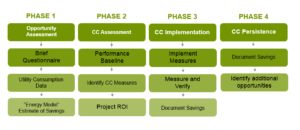Cx Monitor: How Can We Be More Efficient?
Every building owner has to ask themselves that question. It’s inevitable and a long, hard look at the answer can sometimes be what stands between them and significant cost savings. It comes at no surprise that the biggest energy and cost drain is the HVAC system. So, the next question is then, “How much will it cost to replace this old equipment?” But here’s the good news: capital investment is not a prerequisite to reducing energy consumption and cost in an existing building.
Through a process called Continuous Commissioning®, developed by Texas A&M University, long-term savings can be obtained with an ongoing monitoring of energy consumption. The process focuses on optimizing a facility’s already-existing heating, ventilation, and air conditioning (HVAC) system operation and control. SSRCx is one of only a few companies in the world licensed to provide Continuous Commissioning® services.
The process helps create higher efficiencies, increases occupant comfort, and, in most building types, allows for payback of investment in less than three years through energy savings.
“How does it work?”

Continuous Commissioning® (CCx) is conducted in four phases: opportunity assessment, CCx assessment, CCx implementation, and CCx persistence. The first phase, which SSR offers free of charge, is the information-gathering stage. A commissioning agent will conduct a brief questionnaire and gather utility consumption data. From this basic information, an energy model analysis is performed to predict a range of savings that can potentially be achieved at the facility by instituting the CCx process.
Phase two involves a thorough onsite investigation by qualified engineers to measure and assess how the HVAC system is currently operating. They work with controls technicians that regularly service the building and on-site staff to document equipment operational sequences, master equipment lists, operation schedules, and critical operational issues. Perhaps the problem stems from sensors that are out of calibration, or dampers that are broken, or heating and cooling systems running at the same time. The commissioning agent or agents can assess the situation and isolate the issues, and create solutions to help the system run more efficiently. At the end of this phase, the client is given a detailed report that includes the following: a building operation manual including equipment lists, the sequence of operations, a master issues list of deficiencies found, a building energy benchmark, a list of CCx savings measures, and a projected energy and dollar savings, as well as many other helpful items to understand your building better.
Once the problem(s) and solution(s) are identified, phase three, implementation, can begin. It is during this stage, which typically lasts between 12 and 18 months, that the systems may be reprogrammed to new measures, a list of tasks may be created for building staff to implement during this time, and measures are taken to verify once those tasks have been implemented and completed. Phase four, persistence, is for the ongoing monitoring and adjusting, if needed, to continue keeping energy costs down and savings to accumulate.
“Sure, this works in theory. But how does it look in the real world?”
Baycare Health System’s St. Joseph’s Hospital North is a three-story facility, located just north of Tampa in Lutz, Florida, and holds the distinction of being the first LEED Certified® acute care hospital in the state of Florida.
SSRCx was contracted by the hospital to evaluate the operational efficiency of the existing HVAC and lightings systems, identify deferred maintenance items that may be impacting overall operational efficiency, identify cost-effective energy savings opportunities design to resolve operating problems, and identify potential retrofits or capital-intensive projects for future consideration.
During phases one and two, 12 specific recommendations were identified, the most significant of these being converting 14 of the 24 air handling units and corresponding constant volume terminal boxes to a variable air volume mode. A calibrated energy model was created, and the savings were estimated, if all recommendations were implemented, at $335,000 per year, yielding a 1.82 year payback and a 55% return on investment into the CCx process.
SSRCx began work on phase three in April 2015. The hospital has, from June 2015 through December 2016, saved a cumulative of $490,639 in energy costs, or approximately $310,000/yr in savings. St. Joseph’s Hospital North’s Energy Star score went from 4 in 2013 to 23 by mid-2016. Phase four, the continued monitoring and identification of any additional opportunities, began in early 2017. Savings will continue to be documented as well in this phase.
The prospect of having to invest time and money into an energy- and cost-saving effort sometimes seems counterintuitive, but the sooner commissioning is started, the sooner savings and the payback period can begin. With Continuous Commissioning® the building owner can rest assured they are getting professional services from qualified engineers and a transparent, proven process of achieving savings. The investment put into Continuous Commissioning® on a building, whether it is a year old or 10 years old, can yield savings that can then be reinvested into retrofits or other energy- and cost-saving measures.
If you would like more information on Continuous Commissioning® services or would like a personalized CCx presentation, please contact Media Relations at mediarelations@ssr-inc.com.







